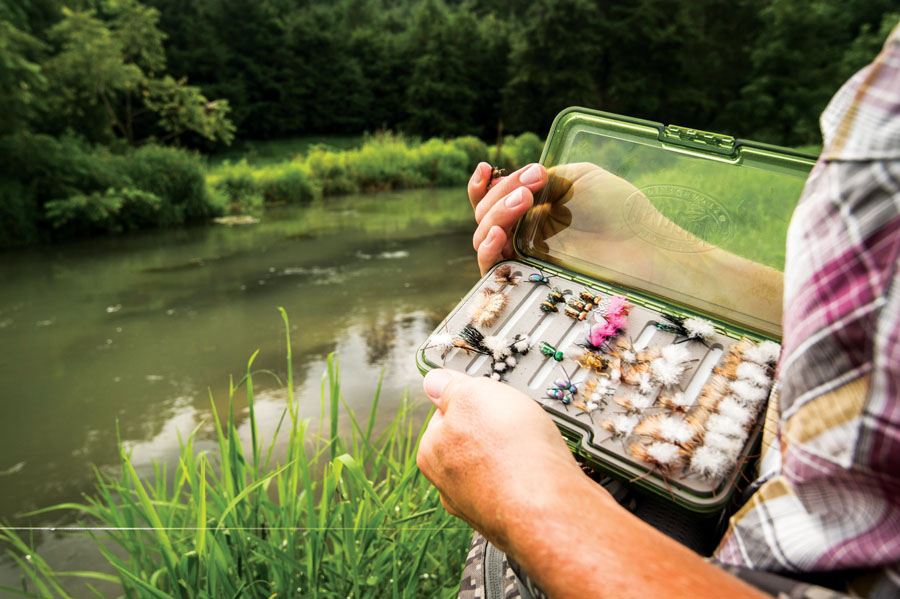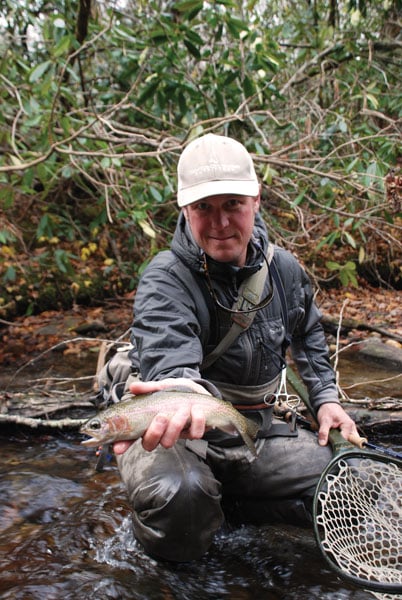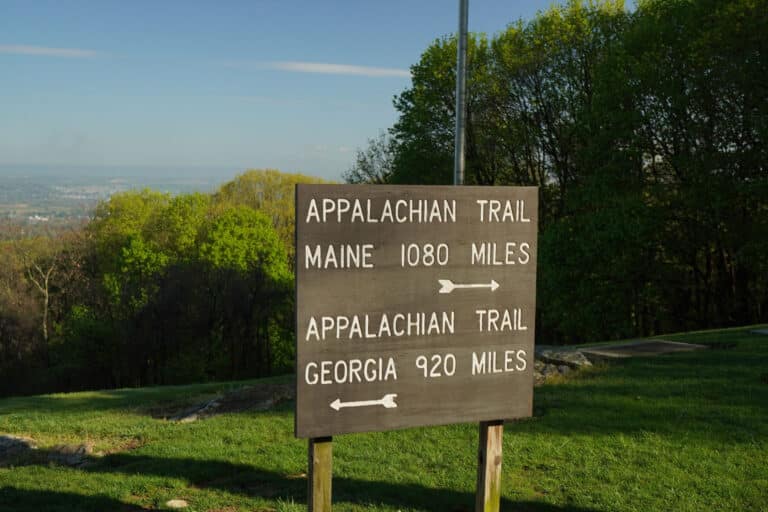From the Cherokee who lived and prospered in the mountains for centuries, to the modern angler who flies into Asheville in his jet from Miami for a weekend in the mountains, the Blue Ridge has always offered great fishing for trout.
For years the trout fishing in the Blue Ridge Mountains was a closely guarded secret, not just by anglers, but the rough and rugged terrain of the region helped protect the fisheries as well. It was not until after World War II and the improvement of roads and infrastructure that the region began to grow in popularity. Today the Southeast is the fastest growing region for fly fishing in the United States.
The Blue Ridge Mountains offer thousands of miles of trout streams, but these six favorites also offer some of the most consistent flows. And each of these streams is a springboard for exploring more secluded creeks in the area. You may find a quiet new spot and maybe the greatest fish story ever told.
Davidson River
Pisgah Forest, North Carolina
The Davidson River has long been the flagship of freestone fisheries in the Southeast. Over the years I have seen dozens of native brown trout greater than 28 inches (eight pounds) caught from the river. The Davidson was the first stream in the southeastern United States to be designated as catch and release fly fishing only. It has produced the North Carolina State Record Brown Trout three times.
Part of the reason for the Davidson’s success is its insect population. The insect life in the Davidson has remained strong, with the exception of the green drake. The green drake population was one casualty from the 1995 flood that swept away the bridge at the Fish Hatchery and destroyed parts of Forest Service Road 475. The drakes were just beginning to show back up when our friends Hurricane Francis and Ivan came rolling through and flushed all of the drakes away again. Today the green drake population is slowly starting to rebuild. Even with the absence of the drakes, the caddisflies, stoneflies and other mayflies are doing well and offer consistently reliable hatches.
Photo Courtesy of Kevin Howell
The Davidson receives a lot of angling pressure, especially from May through early October. In the late summer months of July and August, anglers will also encounter a large bikini hatch (tubers – for those of you unfamiliar with this local river resident), especially on the lower sections of the river near the Davidson River Campground. The best fishing will be from late February through late June and again in the fall from mid-September through late December. For those who prefer some solitude, the cooler shoulder months of March and November offer some of the best fishing of the year and a lot fewer people.
Anglers fishing the Davidson want to come prepared with a good five weight fly rod with a matching floating fly line. Most fishermen prefer leaders from nine to twelve feet in length and that taper to a 5x tippet for the majority of the year and 6x for the summer months. Spring fishermen will want to have a good selection of nymphs along with some dry flies. During the summer months, the river is a great terrestrial fishery with beetles being the fly of choice. During the fall, a bright colored dry with a bead head dropper will usually find some good fish. Streamers will work especially well during times of high water or off-colored water. During the winter months, midges and small heavily weighted streamers will produce a lot of fish.
Cataloochee Creek
Cataloochee Valley, North Carolina
Surrounded by the 6,000 foot peaks of the Balsam Range, Cataloochee Valley is one of the most remote and beautiful areas in Great Smoky Mountains National Park. Due to its remoteness and the protection offered by the park, the rivershed did not suffer the deforestation and heavy logging that was so rampant in the Southern Appalachians in the early 20th century. To this day the extreme remoteness of the valley and creeks still helps protect it from major crowds of people.
Cataloochee Creek runs for seven miles from the confluence of Palmer and Caldwell forks to its confluence with the Pigeon River in Waterville Lake. In addition to Cataloochee Creek, anglers should also spend some time fishing Rough Fork, Caldwell, Palmer, and Little Cataloochee Creeks all offer excellent dry-dropper opportunities. Most of the sections of these creeks will require some bushwhacking and walking back downstream to get to the access points.
For the main river, anglers will want an eight- to nine-foot fly rod preferably in a 4-5 weight. Long leaders and an accurate cast will be needed also, not due to pressure but because of the crystal clear water and all of the time the fish have to inspect your fly. Cataloochee Creek will offer anglers opportunities to catch brown, rainbow, and brook trout. Those who venture below the Highway 284 bridge will also encounter smallmouth bass, some of which will reach three pounds or better. Anglers targeting the smaller streams will want a six- to eight-foot rod probably in a three weight. The brook and rainbow trout in the smaller streams will take almost any well presented dry on 5x tippet.
The best months for anglers to venture into the valley are March to May and September to November. Anglers visiting in the fall need to be mindful of the Valley’s ever-growing elk herd. While no one has ever been harmed by an elk in the valley, they will sure startle an unsuspecting angler.
Mossy Creek
Bridgewater, Virginia
Mossy Creek is a world class limestone creek that flows from Mt. Solon Virginia to the North River. Approximately half of the river’s eight miles are open to the public. The river is managed under special regulation from the Virginia Department of Game and Inland Fisheries. Anglers wanting to fish the river will need to obtain a special permit from the VDGIF.
Like most limestone streams, Mossy Creek has an extraordinary insect population and very reliable hatches. The river is open year round and winter anglers will even find some dry fly action in the form of BWOs and midges. Like most other limestone creeks, spring will bring hatches of sulphers, green and yellow drakes, caddis, and other mayflies. Summer will bring great terrestrial action to the river in the form of small hoppers and especially beetles and tricos of an early morning. Like its freestone counterparts, high water or off-colored water will bring large trout out from under the banks in search of food. During the high water, streamers will produce high numbers of trout along with some of the largest specimens in the river.
Anglers traveling to Mossy Creek will want to bring a large selection of rods ranging from three weights all the way through seven weights for the large nasty streamers. For most situations, anglers will want a good 4 or 5 weight rod and 6x tippet although picky fish and water conditions may dictate 7x and small flies. High water conditions will warrant a six or seven weight rod and 10- to 15-pound test tippet.
Unlike some of the other streams in the area, Mossy Creek will fish well most of the summer due to the cool water spring that feeds the creek. Rainy and heavy overcast summer days will almost always trigger a good hatch of insects.
Toccoa River
Blue Ridge, Georgia
The Toccoa is so beloved that it’s often referred to as the Trout Capital of Georgia. Cool water from the Blue Ridge dam provides a year round fishery in a state that has very few year-round cold-water fisheries. The Toccoa flows for 15 miles through north Georgia before crossing into Tennessee and forming the Ocoee River.
For wade anglers, the only access points on the Lower Toccoa are Horseshoe Bend, Tammen Park, Curtis Switch, and Power House River Access. Due to the limited wading access, these four accesses can be rather crowded on nice weekends during the peak season. Anglers who want to float the river will find access a lot easier and will find it considerably easier to escape the crowds.
Summertime will offer great terrestrial fishing and some sporadic hatches of caddis. During spring the river will come to life with hatches of mayflies and caddis flies. Anytime that the TVA is generating water out of the Blue Ridge Dam or in times of higher water, streamers will produce some larger fish. Streamers will also work well in the fall when the trout are feeding up for the winter.
The river is open and offers easy casting; anglers will want to bring a nine foot 4-6 weight rod. The fish on the Toccoa are not really leader shy and 9-12 foot leaders tapered to 5 or 6x tippet will work fine. A well-presented soft hackle pheasant tail in size 16 will almost always produce some fish on the Toccoa.
Chattooga River
Cashiers, North Carolina / Clayton, Georgia / Walhalla, South Carolina
The Chattooga River begins just south of Cashiers, N.C., and flows south. Ellicott Rock, located beside the Chattooga River, forms the border between North Carolina, South Carolina and Georgia. From Ellicott Rock south, the river is the dividing point between Georgia and South Carolina. The river was one of the first to receive a wild and scenic designation, which has protected the river from a lot of commercial development.
With all of section 0 lying in Ellicott Rock Wilderness Area, this section is accessible only to those brave souls who are willing to make the long hike into and then out of the wilderness area. Section 1 offers some remote stretches on the upper reaches, but Reed Creek downstream to the Highway 28 Bridge is one of South Carolina’s top delayed harvest streams.
The river will fish well all year, but the delayed harvest section is best from late fall through late spring. The river offers decent mayfly hatches in the spring, especially Hendrickson’s and yellow drakes in the month of May. The best fishing this time of year often occurs from 4pm until it is so dark you can’t see. The delayed harvest section can get busy on the nice weekends due to the river’s proximity to Greenville, S.C., and Atlanta, Ga.
Anglers will want a nine foot , 4-6 weight rod for the majority of the fishing on the Chattooga. Leaders tapered to 5-6x tippet and 9 feet in length will be more than sufficient. For those anglers fishing the delayed harvest section, your regular flies will work fine; for those who want to venture upstream into the wilderness area, be sure to carry along several heavily weighted nymphs like a Kevin’s stonefly or a sheepfly so that you can reach the bottom of the larger pools.
Seneca Creek
Pendleton County, West Virginia
Seneca Rocks has always been a draw for rock climbers. Spruce Rocks National Recreation Area and Monongahela National Forest offer anglers quality fishing for brown, rainbow, and brook trout. The towering rocks of River Knobs will offer one of the most scenic settings that anglers will find in the country.
The North Fork of the South Branch forms high in the Alleghany Mountains. Anglers will find sections of the rivers that are classified as catch and release, while other sections have more liberal harvest limits. The best access is off of Highway 28/55 and near Spruce Knob Recreation Area. For those that are looking for some seclusion try staying at Harman’s North Fork Cabins and enjoy fishing their private stretch of the North Fork.
Most fish in the North Fork Range in the 12-15 inch range although a twenty inch fish is not uncommon. Bring your favorite five weight fly rod and a good selection of flies. Streamers and nymphs will work in times of high water and in the deeper pools along 28/55, while dry flies and dry droppers will work better upstream.
Anglers who prefer small streams should focus their efforts on Seneca Creek, which flows through Monongahela National Forest and enters the North Fork near the town of Seneca Rocks. The fishing in Seneca Creek is mostly pocket water fishing for smaller rainbows and native brook trout. This is a great place to use your Tenkara rod or enjoy a day with 7’9” 3 wt. fly rod and some fluffy dry flies.
As the fishing in the region has become more popular, it is more important than ever that we as anglers protect the resource. When the water gets too warm to trout fish, then explore some of the great smallmouth bass fishing in the Blue Ridge. Whether you are fishing the Davidson in the winter or floating the Toccoa in July, enjoy your time out on the water.
Kevin Howell is the owner of Davidson River Outfitters and is co-author of 50 Best Places to Fly Fish in the Southeast due out in 2016.









